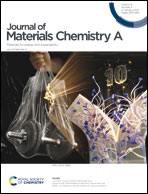Comparative study of polycrystalline and single-crystal NCM811 cathode materials: the role of crystal defects in electrochemical performance
Abstract
This study investigates the electrochemical performance of polycrystalline and single-crystal NCM811 materials. Our findings show that the polycrystalline sample has a higher discharge capacity and better C-rate performance than the single-crystal sample, while single crystal materials exhibit better capacity retention and cycling stability. We also find that crystal structure defects caused by Li/Ni mixing play an important role in structural stability during electrochemical cycling. In contrast to previous studies, we argue that the stability of single crystals is not only due to the less generation of microcracks but also due to their near-perfect R![[3 with combining macron]](https://www.rsc.org/images/entities/char_0033_0304.gif) m crystal layer structure. Additionally, we find that lattice disorder resulting from crystal fusion rearranges during the transition from polycrystalline to single crystal morphology can significantly affect the release of electrochemical properties of the material. Our study suggests that reducing crystal structure defects in polycrystalline materials and improving lithium ion diffusion in single crystal materials can enhance their electrochemical performance. Our study provides valuable insights into the relationship between crystal morphology and electrochemical performance, which can guide the design and synthesis of high-performance cathode materials for lithium-ion batteries.
m crystal layer structure. Additionally, we find that lattice disorder resulting from crystal fusion rearranges during the transition from polycrystalline to single crystal morphology can significantly affect the release of electrochemical properties of the material. Our study suggests that reducing crystal structure defects in polycrystalline materials and improving lithium ion diffusion in single crystal materials can enhance their electrochemical performance. Our study provides valuable insights into the relationship between crystal morphology and electrochemical performance, which can guide the design and synthesis of high-performance cathode materials for lithium-ion batteries.



 Please wait while we load your content...
Please wait while we load your content...